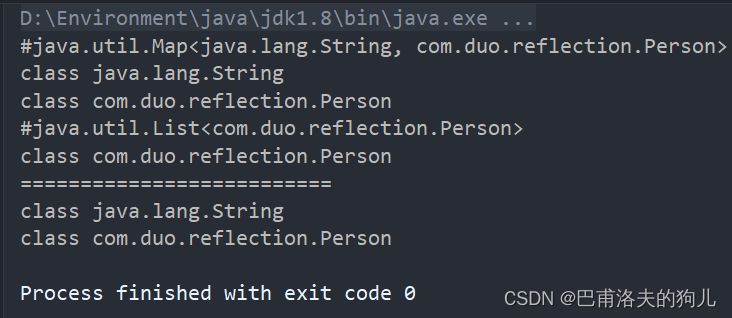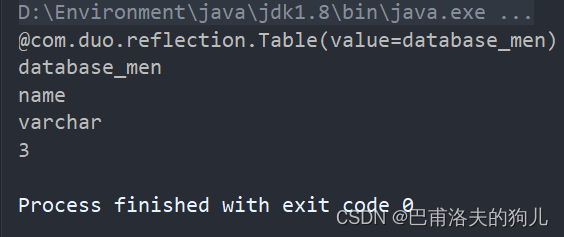反射
05 性能对比分析
下面对比了通过普通new方式、反射方式及关闭Java语言安全检测的反射方式三种情况下,程序的性能(所需时间)。
package com.duo.reflection;import java.lang.reflect.InvocationTargetException;
import java.lang.reflect.Method;//性能测试
public class Test8 {//1.普通方式newpublic static void test1() {Person person = new Person();long startTime = System.currentTimeMillis();for (int i = 0; i < 100000000; i++) {String name = person.getName();}long endTime = System.currentTimeMillis();System.out.println("普通方式(new)调用执行1亿次所需时间:" + (endTime - startTime) + "ms");}//2.反射方式调用public static void test2() throws NoSuchMethodException, InvocationTargetException, IllegalAccessException {Person person = new Person();Class<? extends Person> c1 = person.getClass();Method getName = c1.getMethod("getName", null);long startTime = System.currentTimeMillis();for (int i = 0; i < 100000000; i++) {getName.invoke(person, (Object[]) null);}long endTime = System.currentTimeMillis();System.out.println("反射方式调用执行1亿次所需时间:" + (endTime - startTime) + "ms");}//3.关闭Java语言安全检查调用public static void test3() throws NoSuchMethodException, InvocationTargetException, IllegalAccessException {Person person = new Person();Class<? extends Person> c1 = person.getClass();Method getName = c1.getMethod("getName", null);getName.setAccessible(true);long startTime = System.currentTimeMillis();for (int i = 0; i < 100000000; i++) {getName.invoke(person, (Object[]) null);}long endTime = System.currentTimeMillis();System.out.println("关闭安全检测以反射方式调用执行1亿次所需时间:" + (endTime - startTime) + "ms");}public static void main(String[] args) throws InvocationTargetException, NoSuchMethodException, IllegalAccessException {test1();test2();test3();}
}
运行结果:

由此可见,通过反射方式调用执行会影响程序效率,而采用了setAccessible()关闭语言安全检测之后可以提高效率。
06 反射操作泛型
-
Java采用泛型擦除的机制来引入泛型,Java中的泛型仅仅是给编译器javac使用的,确保数据的安全性和免去强制类型转换问题,但是一旦编译完成,所有和泛型有关的类型全部擦除
-
为了通过反射操作这些类型,Java新增了ParameterizedType,GenericArrayType,TypeVariable和WildcardType几种类型来代表不能被归一到Class类中的类型但又和原始类型齐名的类型
- ParameterizedType:表示一种参数化类型,例如Collection
- GenericArrayType:表示一种元素类型是参数化类型或者类型变量的数组类型
- TypeVariable:是各种类型变量的公共父接口
- WildcardType:代表一种通配符类型表达式
-
获取泛型信息:
package com.duo.reflection;import java.lang.reflect.Method;
import java.lang.reflect.ParameterizedType;
import java.lang.reflect.Type;
import java.util.List;
import java.util.Map;//通过反射获取泛型
public class Test9 {public void test01(Map<String, Person> map, List<Person> list) {}public Map<String, Person> test02() {System.out.println("test02");return null;}public static void main(String[] args) throws NoSuchMethodException {Method method = Test9.class.getMethod("test01", Map.class, List.class);Type[] genericParameterTypes = method.getGenericParameterTypes(); //获得泛型的参数类型for (Type genericParameterType : genericParameterTypes) {System.out.println("#" + genericParameterType);//instanceof:用来在运行时指出对象是否是特定类的一个实例if (genericParameterType instanceof ParameterizedType) {Type[] actualTypeArguments = ((ParameterizedType) genericParameterType).getActualTypeArguments();for (Type actualTypeArgument : actualTypeArguments) {System.out.println(actualTypeArgument);}}}System.out.println("==========================");method = Test9.class.getMethod("test02");Type genericReturnType = method.getGenericReturnType(); //获得泛型返回值类型if (genericReturnType instanceof ParameterizedType) {Type[] actualTypeArguments = ((ParameterizedType) genericReturnType).getActualTypeArguments();for (Type actualTypeArgument : actualTypeArguments) {System.out.println(actualTypeArgument);}}}
}
运行结果:

07 反射操作注解
-
getAnnotations
-
getAnnotation
-
了解什么是ORM?
-
Object relationship Mapping --> 对象关系映射
-
class Student {int id;String name;int age; } -
上述对应:
id name age 001 Li 32 002 Wang 24 -
即,类和表结构对应、属性和字段对应、对象和记录对应
-
-
反射操作注解:
package com.duo.reflection;import java.lang.annotation.*;
import java.lang.reflect.Field;//反射操作注解
public class Test10 {public static void main(String[] args) throws ClassNotFoundException, NoSuchFieldException {Class<?> c1 = Class.forName("com.duo.reflection.men");//通过反射获得(类名的)注解Annotation[] annotations = c1.getAnnotations();for (Annotation annotation : annotations) {System.out.println(annotation);}//获得(类名的)注解的value值Table annotation = c1.getAnnotation(Table.class);String value = annotation.value();System.out.println(value);//获得类指定的注解Field id = c1.getDeclaredField("name");Attribute annotation1 = id.getAnnotation(Attribute.class);System.out.println(annotation1.columnName());System.out.println(annotation1.type());System.out.println(annotation1.length());}
}@Table("database_men")
class men {@Attribute(columnName = "id", type = "int", length = 10)private int id;@Attribute(columnName = "age", type = "int", length = 10)private int age;@Attribute(columnName = "name", type = "varchar", length = 3)private String name;public men() {}public men(int id, int age, String name) {this.id = id;this.age = age;this.name = name;}public int getId() {return id;}public void setId(int id) {this.id = id;}public int getAge() {return age;}public void setAge(int age) {this.age = age;}public String getName() {return name;}public void setName(String name) {this.name = name;}@Overridepublic String toString() {return "man{" +"id=" + id +", age=" + age +", name='" + name + '\'' +'}';}
}//类名的注解
@Target(ElementType.TYPE)
@Retention(RetentionPolicy.RUNTIME)
@interface Table {String value();
}//属性的注解
@Target(ElementType.FIELD)
@Retention(RetentionPolicy.RUNTIME)
@interface Attribute {String columnName();String type();int length();
}
运行结果:



出现 403 net::ERR_ABORTED 的问题)




![[python]用python获取EXCEL文件内容并保存到DBC](http://pic.xiahunao.cn/[python]用python获取EXCEL文件内容并保存到DBC)






)

:224. 基本计算器)


